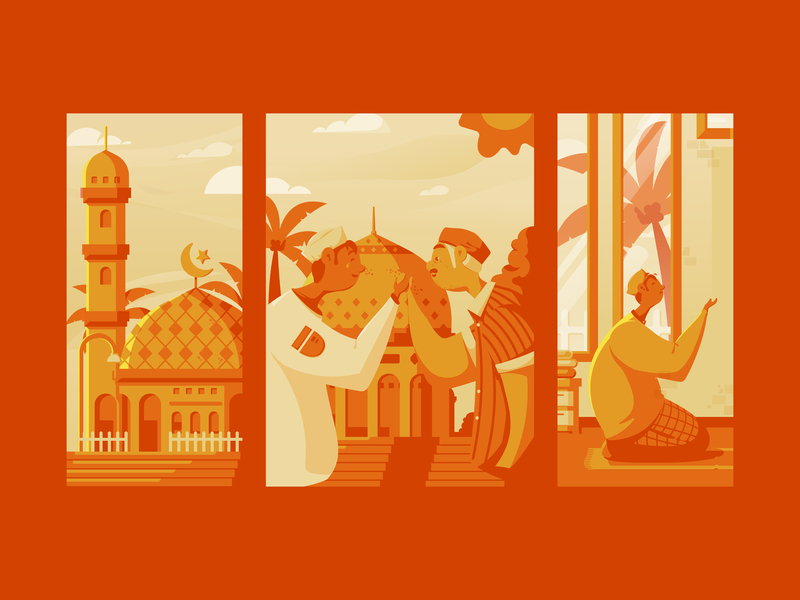
Below is a list of primary colors and their meanings.
Red.
-
- Western Cultures (America and Western Europe): Love, Passion, and Danger. Red is youthful and full of energy.
- Eastern/Asian Cultures: Most Asian cultures consider red to be good luck, long life and happiness. Brides often get married in red to ensure a happy marriage. Especially in India, it brings a pure soul, love, beauty, wealth and power.
- Middle East: Dangerous and cautious but sometimes threatening.
- Latin America: In Latin America red means passion but can also symbolize Christianity when used with white.
- South Africa: In South Africa, red also symbolizes sacrifice and mourning.
Orange

Illustration: Rudy Muhardika
Orange is the color of firelight, leaves in autumn. However it has many meanings all over the world and one of them has little consolation.
-
- Western culture: Orange is the color of autumn and harvest. It also symbolizes the ability to pay. In Northern Ireland, again the color of Protestantism. It is also the national color of the Netherlands, which is associated with royalty. For brands, it’s kid-friendly, fun colors, and attracts impulsive buyers.
- Eastern/Asian Cultures: The orange saffron flower has sacred significance in India, as well as in cultures other than Hindu or Buddhist. In Japan and China, it symbolizes courage, happiness, prosperity and good health.
- Middle East: Danger, funeral and loss.
- Latin America: Orange is associated with the sun and the earth.
Yellow

TDesigner: Viacheslav Olianishyn
Yellow is the color of sunlight. Brands like IKEA, Lipton, and McDonal use yellow for their logos, so that it gives off optimism, a happy vibe…but what about other companies.
-
- Western Cultures: In most Western cultures, the color yellow brings to the heart the warmth of the sun. It is the color of summer. However, in France and Germany, sometimes it’s jealousy.
- Eastern/Asian Cultures: Gold also has a positive connotation in most Asian cultures. In Japan, it is a royal color that represents courage and prosperity. In Thailand, it is a lucky color along with the deceased King Bhumibol. However, in China it is a symbol of pornography.
- Middle East: In Egypt, yellow is the color of mourning. However, it usually has more positive connotations for the rest of the region.
- Latin America: Yellow is a symbol of funerals in Latin America.
- Africa: In Africa, yellow is the color of wealth and status.
Green

Illustration: Owen Gatley
Green is the color of grass and leaves, which is why it often represents nature. It is often considered a calming color.
-
- Western Cultures: In Western cultures, green often connotes jealousy. However, since it is associated with Ireland and the four-leaf clover, it also brings good luck. And because a green traffic light means go, it can symbolize progress. Green is also used in marketing to indicate environmental awareness.
- Eastern/Asian Cultures: Green represents nature, fertility and youth in most Eastern cultures. However, in China it is just infidelity.
- Middle East: In the Middle East, too, green indicates fertility, money and luck. Equally important, it is also the color of Islam.
- Latin/South America: In Mexico, green is the national color and is considered patriotic. However, green is the color of death in a Latin and South American country.
Blue
Calm, peaceful green is a favorite color for international brands. Although its meanings vary across cultures, they all have positive connotations.
-
- Western culture: Blue represents trust and authority. It is associated with purity but also sadness.
- Eastern Cultures: Blue is immortality, healing and relaxation in Asian cultures. In India, it is the color of Krishna and connotes strength.
- Turkey, Greece, Iran, Afghanistan, and Albania: In these countries, the blue talisman leaves the devil blank.
- Middle East: Safety, Protection, and Spirituality. However, it can also be a symbol of funerals.
- Latin and South America: In Mexico, blue can be a sign of mourning.
Purple

Illustration: Walid Beno
Because purple dye used to be expensive to produce, it was often associated with wealth.
-
- Western culture: Purple symbolizes royalty, wealth and fame. However, in some parts of Europe it is associated with death.
- Eastern/Asian Cultures: Purple also represents nobility in most Asian cultures. However, it is a symbol of mourning in Thailand.
- Middle East: Again, purple symbolizes wealth.
- Latin America and South America: In Brazil, purple indicates mourning or death.
- Africa: Purple is also a symbol of royalty and wealth in Africa.
Black.
What about black? All the colors of the rainbow mixed together, turning into the color of the night, the darkness. Perhaps unsurprisingly, the color black has so many symbolic meanings around the world.
-
- Western Cultures: In Western cultures, black indicates sophistication and formality. However, it is also the main color of death, mourning, funerals. Black is reminiscent of darkness and sometimes the devil.
- Eastern/Asian Cultures: In China, black is the color of young men. It has other positive connotations, like health and prosperity. In Japan, it symbolizes mystery and feminine energy. In India, it can symbolize evil, rebellion, or death.
- Latin America/South America: Black indicates masculinity and can also be used for funerals.
- Middle East: In the Middle East, black indicates evil, mystery and mourning. However, it can also refer to rebirth.
- Africa: Black indicates maturity and masculinity in some African cultures.
White.

Design: Nicola Baldo
White is often used as a background color with no meaning of its own. That said, it is still valid in different cultures.
-
- Western culture: White symbolizes purity, innocence, gentleness and peace. In Italy, however, it is traditionally used for funerals.
- Eastern/Asian cultures: In most Eastern cultures, white indicates death and mourning, as well as unhappiness.
- Middle East: White is reminiscent of both purity and mourning in the Middle East
- Latin America / South America: In Latin and South America, white also means peace
- Africa: In Africa, white symbolizes peace, purity, goodness and luck. However, in Ethiopia it also refers to disease.

![What is Infographic? How to design beautiful and attractive Infographic [Template] 17 infographic la gi](https://maludesign.vn/wp-content/uploads/2022/12/infographic-la-gi-500x500.webp)


